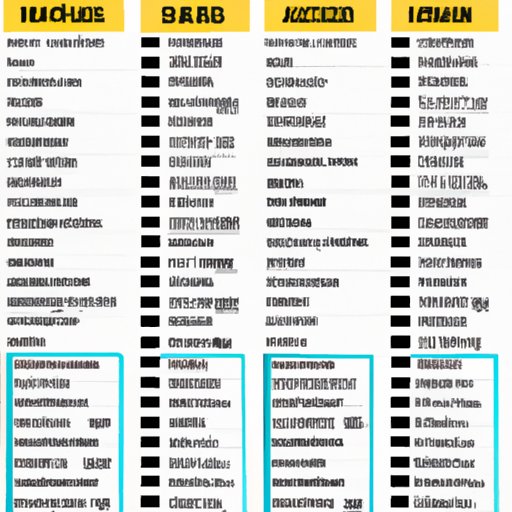Introduction
A nutrition label is a list of the ingredients, nutrients, and other information found in a particular food or drink product. It is typically printed on the packaging of the item and is used to inform consumers about the item’s nutritional value. The purpose of a nutrition label is to provide clear and concise information about the item’s calorie count, macronutrients, micronutrients, and serving size. By understanding how to create a nutrition label, companies can ensure that they are providing accurate information to their customers.

Outline the Components of a Nutrition Label
The first step in creating a nutrition label is to outline the components that must be included. There are several different elements that should be included in order to provide complete and accurate information. These include:
Calorie Count
The calorie count is the number of calories in a single serving of the item. This is important for consumers who are watching their caloric intake or trying to maintain a certain body weight. It is also useful for those who are trying to gain or lose weight, as it helps them to track their daily calorie intake.
Macronutrients and Micronutrients
The next component of a nutrition label is the item’s macronutrients and micronutrients. Macronutrients are essential for human health and include carbohydrates, fats, and proteins. Micronutrients are vitamins and minerals that are necessary for proper bodily functions. A nutrition label should include the amount of each macronutrient and micronutrient in a single serving of the item.
Serving Size
Finally, a nutrition label should include the serving size of the item. This is important because the calorie count, macronutrients, and micronutrients are all based on the serving size. For example, if the serving size is one cup and the calorie count is 100, then this means that there are 100 calories in one cup of the item.

Explain How to Calculate the Nutritional Values
Once the components of the label have been outlined, it is time to calculate the nutritional values. This can be done using calculation tables, which provide all of the necessary information to accurately calculate the nutritional values. Additionally, there are guidelines that can be followed to ensure that the measurements are accurate. These include using measuring cups and spoons, weighing items on a kitchen scale, and using a calculator to convert measurements.

Provide Tips on Accurately Measuring Serving Sizes
When measuring serving sizes, it is important to consider the type of food being measured. For example, a cup of cereal will have a different serving size than a cup of rice or pasta. Additionally, it is helpful to use tools such as measuring cups, spoons, and scales to ensure accuracy. This will help to avoid any discrepancies when calculating the nutritional values.
Discuss the Benefits of Including a Nutrition Label
Including a nutrition label on a product’s packaging has several benefits. First, it improves the consumer experience by providing them with information about the item’s nutritional value. This can help them make informed decisions when purchasing food and drinks. Additionally, including a nutrition label can lead to increased sales as consumers may be more likely to purchase a product if they know its nutritional content.

Showcase Examples of Successful Nutrition Labels
To get an idea of what a successful nutrition label looks like, it is helpful to analyze examples of existing labels. When examining the design of a label, look for font sizes that are easy to read, legible fonts, and attractive colors. Additionally, it is important to examine the content of the label and make sure that all of the necessary information is included. This includes the calorie count, macronutrients, micronutrients, and serving size.
Demonstrate How to Design an Appealing Nutrition Label
Designing an appealing nutrition label is essential for increasing sales and improving the customer experience. When selecting fonts, it is important to choose ones that are easy to read and legible. Additionally, utilizing attractive colors can draw attention to the label and make it stand out from other products. Finally, it is helpful to add visuals such as illustrations or diagrams to make the label more eye-catching.
Offer Advice on Complying with Food Labeling Regulations
In order to ensure that a nutrition label is compliant with local food labeling regulations, it is important to do research and understand the regulations that apply to the product. Additionally, it is helpful to reach out to regulatory bodies and ask questions about any specific requirements. This can help to ensure that the label is accurate and compliant with all applicable laws.
Conclusion
Creating a nutrition label is a complex process but is essential for providing accurate information to customers. By outlining the components of a nutrition label, explaining how to calculate nutritional values, offering tips on measuring serving sizes, showcasing examples of successful nutrition labels, demonstrating how to design an appealing nutrition label, and offering advice on complying with food labeling regulations, companies can ensure that they are providing accurate and up-to-date nutritional information to their customers.
By following these steps, companies can create nutrition labels that are both accurate and attractive, resulting in improved customer experience and increased sales.
(Note: Is this article not meeting your expectations? Do you have knowledge or insights to share? Unlock new opportunities and expand your reach by joining our authors team. Click Registration to join us and share your expertise with our readers.)
